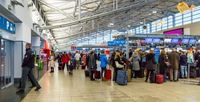On October 12, 2025, a new chapter began for travelers crossing into the European Union as the much-anticipated Schengen Entry-Exit System (EES) officially launched. The system, which will be gradually rolled out across all EU and Schengen Area border crossings, is set for full operational status by April 10, 2026. Its debut, however, was anything but smooth, as airports from Prague to Madrid braced for—and experienced—significant teething problems, long queues, and a flurry of last-minute advisories.
The EES represents a seismic shift in how the EU manages its borders. Gone are the days of manual passport stamping. Instead, non-EU travelers will now have their personal and biometric data—including fingerprints and facial images—digitally collected and stored each time they enter or exit the Schengen Area. According to Abdullah Al Rajhi, spokesperson for Kuwait’s Directorate General of Civil Aviation (DGCA), the system is designed to "strengthen border security and improve the registration process for travelers entering and exiting the EU." He urged travelers to carefully follow all related instructions and to plan ahead for longer processing times, especially during the initial rollout. "Travelers departing from Kuwait International Airport to EU or Schengen destinations should arrive at European airports at least three hours before departure to complete all necessary travel formalities without delays," Al Rajhi advised, as reported by Arab Times.
The rollout’s impact was felt most acutely at Prague Airport, one of only three EU airports (alongside those in Estonia and Luxembourg) to implement full biometric checks from day one. According to The Independent, the airport installed dozens of self-service kiosks at Terminal 1, intended to streamline the biometric data collection process. But technical glitches meant that on launch day, none of these kiosks were operational. Border staff were left to manually process all arriving passengers, leading to wait times of up to 90 minutes for non-EU travelers, particularly those arriving from London, Turkey, Egypt, and the United Arab Emirates.
Passengers described the experience as chaotic. "I just fought through the queues. No machines [kiosks were] operating," one traveler arriving from London told The Independent. Another, flying from Prague to Leeds, recounted: "All machines are still switched off…for about an hour now. Fingers and eyes [biometrics] are being done at the passport control desk." The non-EU immigration queue, according to another traveler, "stretches all the way across the airport. Never seen anything like it in all the years I’ve been coming here." In an attempt to ease the congestion, staff eventually allowed Australian and British passport holders to use the EU citizen channel, though this was a temporary measure.
The delays were not entirely unexpected. Industry leaders had sounded the alarm well in advance. Michael O’Leary, CEO of Ryanair, predicted to The Independent before the launch, "I’m pretty certain it’s going to go wrong." Mark Tanzer, chief executive of the travel association Abta, echoed these concerns, stating, "I’m afraid there will undoubtedly be some delays as this new entry and exit system for the Schengen area comes into effect." Julia Lo Bue-Said, head of the Advantage Travel Partnership, advised travelers on BBC’s Today programme to "leave yourself between three and four hours from the point of entry" before continuing with travel plans, warning that "this is going to add another layer of frustration and delay."
Prague Airport, for its part, had ramped up staffing and adjusted signage at passport control in anticipation of the new system. Czech Foreign Police spokesperson Josef Urban told Expats.cz, "Prague Airport has boosted personnel. Navigation and signage at passport control have also been adjusted to make it easier for passengers to find out which passport counter to go to with their document." Announcements were made every 15 minutes to keep travelers informed, and the airport’s message was clear: better early than sorry. Urban reiterated, "We recommend that passengers arrive at the airport well in advance, ideally at least three hours before departure."
Elsewhere in Europe, the transition was set to be more gradual. In Spain, for example, the EES will begin operation at Lanzarote airport on November 12, with a nationwide rollout following a phased approach: airports first, then land borders, and finally maritime entries. Pedro Vieira, island director of the General State Administration, told La Voz that the current team, bolstered by 11 additional officers and support from the BRIC brigade, was "sufficient for the control of people arriving from third countries." Spain has invested 83 million euros to adapt its border posts to the new technical requirements, with the Ministry of the Interior overseeing the upgrades. During the six-month trial period, the EES will coexist with traditional passport stamping, which will be phased out entirely by April 2026.
The EES is not just about efficiency; it’s about security and control. The system is designed to register the entry and exit of third-country nationals—such as British citizens post-Brexit—each time they cross an external border of any of the 29 Schengen countries. The goal is to ensure that travelers do not exceed the maximum allowed stay of 90 days within any 180-day period. If a traveler requires a visa, the system will store their passport data and facial image (since fingerprints are already recorded during the visa application process). For those who do not need a visa, four fingerprints will be collected in addition to other personal data.
However, the transition is not without growing pains. In Lanzarote, crowding at the airport has been attributed to both the design and infrastructure of the facility and the sheer concentration of flights. Vieira noted that, in a space of just 400 square meters, the airport handles around 240 incoming and 240 outgoing flights each week—a 60% increase since Brexit. "Agglomerations like the one that occurred on February 27 are related to the concentration of flights in a very short time. That day there were 16 flights in 65 minutes," Vieira explained.
Across the Schengen area, the stakes are high. The region comprises most EU countries plus Iceland, Norway, and Switzerland, with more than 1,800 border crossings and over 500 million entries and exits annually. The new system is meant to streamline movements, provide reliable data on border crossings, and help authorities systematically detect overstays. Yet, as the events of October 12 made clear, the path to seamless digital borders is paved with unexpected obstacles.
For now, travelers are advised to heed the warnings: arrive early, expect delays, and be patient as Europe’s border control enters the digital age. The next few months will be a crucial test for the EES—and for the millions who cross Europe’s borders each year.






